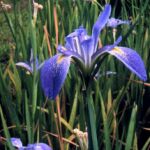| Common Name: |
Dragonflower |
| Other Names: |
Blue Flag, Fleur-de-Lis, Snake Lily, Wild Iris |
| Botanical Name: |
Iris versicolor |
| Genus: |
Iris |
| Family: |
Iridaceae |
| Cultivation: |
Well-drained, neutral to alkaline soil in sun (I. germanica var. florentina); rich, moist to wet, acid soil or shallow water in sun (I. versicolor). |
| Propagation: |
By seed sown in autumn or spring; by division or offsets in summer. Cultivars may not come true from seed. |
| Harvest: |
Rhizomes are lifted in the late summer and early autumn, and dried for use in decoctions, liquid extracts, and powders. |
| Native Location: |
Northeastern N America |
| Height: |
50cm-1m (20in-3ft) |
| Width: |
Indefinite |
| Variations: |
Kermesina
Has Plum colored flowers. |
| Hardiness: |
Z3-8 |
| Parts Used: |
Rhizomes and roots. |
| Properties: |
An acrid, slightly aromatic, alterative herb that stimulates the liver and gall-bladder, reduces inflammation, increases rates of perspiration and salivation, and acts as a diuretic and laxative. |
| Medicinal Uses: |
Internally for psoriasis, acne, herpes, migraine due to liver dysfunction, arthritis, fibroids, swollen glands, pelvic inflammatory disease, and septicemia. Fresh rhizome causes nausea and diarrhea. Not givento pregnant women. Externally for skin diseases, rheumatism, and infected wounds. Combines well with Phytolacca armericana (See, Indian poke), Rumex crispus (See, curled dock), Stillingia sylvatica (See, queen's delight), or Trifolium pratense (See, red clover), for skin disease.
To treat constipation, infections, sores, bites, and skin eruptions; as a diuretic. |
| Typical Dose: |
A typical dose of blue flag as a laxative may range from 650 to 1300mg of powdered root or 2.5 to 15ml of tincture. |
| Possible Side Effects: |
When taken internally, blue flag's side effects include, nausea, vomiting, irritation of the throat, and headache. When used externally, there may be skin irritation or eye inflammation. |
| Drug Interactions: |
| Taking blue flag with these drugs may increase the risk of hypokalemia (low levels of potassium in the blood): |
| Acetazolamide, (Apo-Acetazolamide, Diamox Sequels) |
Azosemide, (Diat) |
Bumetanide, (Bumex, Burinex) |
Chlorthiazide, (Diuril) |
| Chlorthalidone, (Apo-Chlorthalidone, Thalitone) |
Digitalis, (Digitek, Lanoxin) |
Ethacrynic Acid, (Edecrin) |
Etazolin, (Elkapin) |
| Furosemide, (Apo-Furosemide, Lasix) |
Hydrochlorothiazide, (Apo-Hydro, Microzide) |
Hydroflumethiazide, (Diucardin, Saluron) |
Indapamide, (Lozol, Nu-Indapamide) |
| Mannitol, (Osmitrol, Resectisol) |
Mefruside, (Baycaron) |
Methazolamide, (Apo-Methazolamide, Neptazane) |
Methyclothiazide, (Aquatensen, Enduron) |
| Metolazone, (Mykrox, Zaroxolyn) |
Olmesartan and Hydrochlorothiazide, (Benicar HCT) |
Polythiazide, (Renese) |
Torsemide, (Demadex) |
| Trichlormethiazide, (Metatensin, Naqua) |
Urea, (Amino-Cerv, UltraMide) |
Xipamide, (Diurexan, Lumitens) |
|
| Disease Effects: |
This herb can irritate the gastrointestinal tract and may worsen inflammatory of infectious gastrointestinal ailments. |
| Supplement Interactions: |
|
| Warning: |
All parts of Iris species, especially rhizomes, are harmful if eaten. Skin irritant and allergen. |
| Bibliography: |
Encyclopedia of Herbs by Deni Brown. Copyright © 1995, 2001 Dorling Kindersley Limited. pg. 244
The Essential Herb-Drug-Vitamin Interaction Guide by Geo. T. Grossberg,MD and Barry Fox,PhD, Copyright©2007 Barry Fox,PhD. Pp.89-90
|
